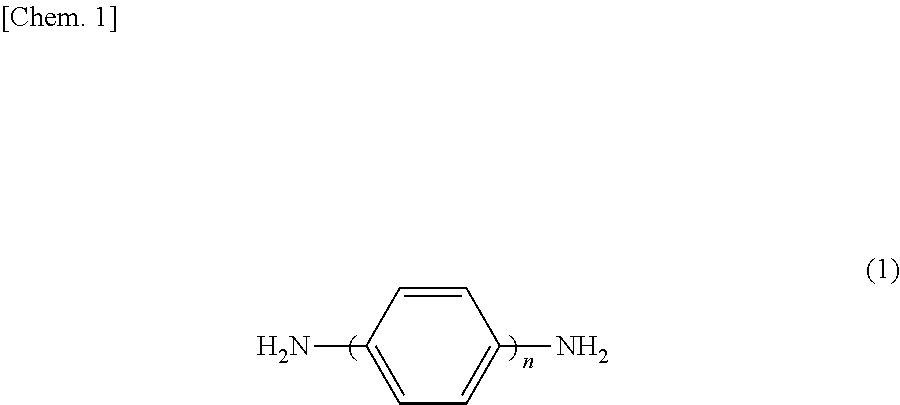Alkoxysilane-modified polyamic acid solution, laminate and flexible device each produced using same, and method for producing laminate
a technology of alkoxysilane and polyamic acid solution, which is applied in the direction of transportation and packaging, other domestic articles, synthetic resin layered products, etc., can solve the problems of glass substrates that are not always ideal substrates, glass substrates are disadvantageously heavy and brittle, and require new production techniques and apparatuses. , to achieve the effect of suppressing a change in viscosity in varnish storage and preventing peeling
- Summary
- Abstract
- Description
- Claims
- Application Information
AI Technical Summary
Benefits of technology
Problems solved by technology
Method used
Image
Examples
example 1
[0093](1-1) Production of Polyamic Acid Solution
[0094]Into a 2 L glass separable flask equipped with a stirrer having a polytetrafluoroethylene sealing plug, a stirring blade, and a nitrogen inlet tube, 850.0 g of N,N-dimethylacetamide (DMAc) having been dehydrated with use of a molecular sieve was introduced. Then, 40.31 g of paraphenylenediamine (PDA) was added. Thereafter, a resultant solution was stirred for 30 minutes in a nitrogen atmosphere while being heated to 50.0° C. in an oil bath. After it was confirmed that ingredients were uniformly dissolved, 109.41 g of 3,3′,4,4′-biphenyltetracarboxylic dianhydride (BPDA) was added. Then, a temperature of the solution was adjusted to approximately 80° C., while the solution was being stirred for 10 minutes in a nitrogen atmosphere until ingredients were completely dissolved. Further, stirring was continued for 3 hours while the solution was heated at a constant temperature. Thereby, a viscosity of the solution was decreased. Further...
example 2
[0100]Except that an addition amount of a 1% DMAc solution of γ-APS was changed to 1.50 g, an alkoxysilane-modified polyamic acid solution was obtained as in Example 1. Note that the addition amount of γ-APS in this reaction was 0.010 part by weight with respect to 100 parts by weight of polyamic acid. Thus obtained solution had a viscosity of 13100 mPa·s at 23° C. and a water content of 2800 ppm. Further, as in the method in Example 1, a laminate of an alkali-free glass plate and a polyimide film that had a thickness of 20 μm could be obtained without spontaneous peeling. Table 1 and Table 2 show a change in viscosity in storage and properties of the polyimide film.
example 3
[0101]Into an experimental apparatus that was the same as that in Example 1, 850.0 g of dehydrated DMAc was introduced. Then, 40.39 g of PDA was added. Thereafter, a resultant solution was stirred for 30 minutes in a nitrogen atmosphere while being heated to 50.0° C. in an oil bath. After it was confirmed that ingredients were uniformly dissolved, 109.34 g of BPDA was added. Then, a temperature of the solution was adjusted to approximately 80° C., while the solution was being stirred for 10 minutes in a nitrogen atmosphere until ingredients were completely dissolved. Further, stirring was continued for 5 hours while the solution was heated at a constant temperature. Thereby, a viscosity was decreased and as a result, a viscous polyamic acid solution exhibiting a viscosity of 25300 mPa·s at 23° C. was obtained. Note that a concentration of an aromatic diamine and an aromatic tetracarboxylic dianhydride which were added in the above reaction solution was 15 weight % with respect to a ...
PUM
| Property | Measurement | Unit |
|---|---|---|
| molar ratio | aaaaa | aaaaa |
| molar ratio | aaaaa | aaaaa |
| viscosity | aaaaa | aaaaa |
Abstract
Description
Claims
Application Information
 Login to View More
Login to View More - R&D
- Intellectual Property
- Life Sciences
- Materials
- Tech Scout
- Unparalleled Data Quality
- Higher Quality Content
- 60% Fewer Hallucinations
Browse by: Latest US Patents, China's latest patents, Technical Efficacy Thesaurus, Application Domain, Technology Topic, Popular Technical Reports.
© 2025 PatSnap. All rights reserved.Legal|Privacy policy|Modern Slavery Act Transparency Statement|Sitemap|About US| Contact US: help@patsnap.com



